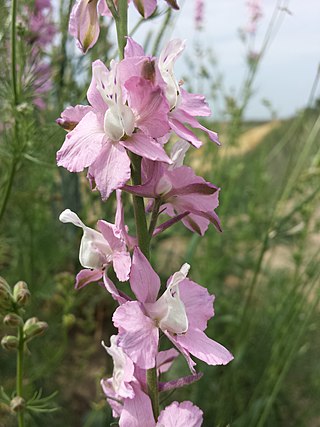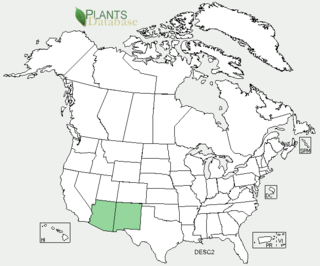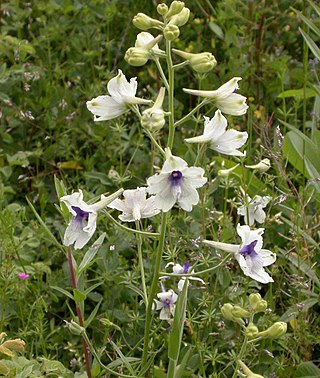
Delphinium is a genus of about 300 species of annual and perennial flowering plants in the family Ranunculaceae, native throughout the Northern Hemisphere and also on the high mountains of tropical Africa. The genus was erected by Carl Linnaeus.

Consolida is a genus of about 40 species of annual flowering plants in the family Ranunculaceae, native to western Europe, the Mediterranean and Asia. Phylogenetic studies show that Consolida is actually an annual clade nested within the genus Delphinium and it has been treated as a synonym of Delphinium in Kew's Plants of the World Online. The name of the genus comes from an archaic use of consolidation, meaning "healing", in reference to the plant's medieval use for healing wounds.

Tolmiea menziesii is a species of flowering plant in the family Saxifragaceae. It is known by the common names youth on age, pick-a-back-plant, piggyback plant, and thousand mothers. It is a perennial plant native to the West Coast of North America, occurring in northern California, Oregon, Washington, British Columbia and southern Alaska. It occurs as a naturalised plant or garden escapee in Scotland, parts of Wales, Northern Ireland and northern and western parts of England.

Delphinium patens is a species of larkspur known by the common names zigzag larkspur and spreading larkspur. It is a wildflower limited mainly to California. Though not yet confirmed there, it is expected in Baja California. Plants grow typically 20 to 50 centimeters tall and bear up to 36 flowers each. The stems are mostly hairless, have reddish bases, and bears leaves on the lower half. Each leaf is divided into 3 to 9 lobes. The flower has dark blue sepals, the latter ones reflexed. The spur at the back of the flower is 4 to 8 millimeters long. The cleft at the center of the flower has white or yellowish scattered hairs. The elongated fruit is one or two centimeters long and contains pitted seeds.

Delphinium glaucum, known by the common names Sierra larkspur, mountain larkspur, and glaucous larkspur, is a species of wildflower in the genus Delphinium, which belongs to the buttercup family, Ranunculaceae. It is native to western North America from Arizona to Alaska, growing in moist mountainous environments such as riverbanks and meadows.

Delphinium hesperium is a species of larkspur known by the common name foothill larkspur. It is also sometimes called western larkspur and coastal larkspur, but these names are less specific since other species share them. It is endemic to California, where it grows in woodland and grassland in the northern half of the state. This wildflower generally reaches one half to one meter in height. It has deeply lobed, prominently veined leaves, mostly located near the base of the plant. The inflorescence may hold very few to over 100 flowers, each on a long, thick pedicel. The flowers are usually a brilliant blue or purple, and sometimes lighter pinkish to white. Often the sepals are dark in color and the petals lighter. The spur is about one to two centimeters long.

Delphinium nuttallianum is a species of larkspur known by the common names two-lobe larkspur, upland larkspur, common larkspur, and Nuttall's larkspur. It is widely distributed across western North America from California to Alberta, including mountain meadows and the majority of the sagebrush steppe, except very dry areas.

Delphinium bicolour is a species of larkspur known as little larkspur and low larkspur. It is native to northwestern North America from British Columbia to South Dakota, where it grows in mountain forests and foothill scrub and prairie. This is a perennial herb growing from a thickly branching root system. It produces solitary stems to 40 centimetres (16 in) in height and green with reddish bases. Most of the leaves are low on the stem and grow on short petioles. They are several centimeters long with many rounded lobes. The small inflorescence holds a few large flowers per stem. The flower has dark purple-blue sepals each about 2 centimeters long and a spur of 1 to 2 centimeters. The plant is poisonous to cattle, less so to sheep, and it is occasionally eaten by various species of wild cervids.

Delphinium polycladon is a species of larkspur known by the common name mountain marsh larkspur. It is native to the High Sierra Nevada and the White and Inyo Mountains of eastern California and far western Nevada, where it grows in wet sites in the talus. It is a perennial herb producing one or more erect stems which easily exceed a meter in height but often remain dwarfed in high-elevation, exposed habitat with thin soils. The leaves are small and mostly located near the base of the plant. The inflorescence is a raceme of up to 35 flowers on long, S-shaped pedicels, often arranged along one side of the stem. The sepals are deep blue to purple, one to two centimeters long, and with a spur up to 2 centimeters in length.

Delphinium scopulorum, commonly known as Rocky Mountain larkspur, is a species of wildflower in the genus Delphinium, which belongs to the buttercup family, Ranunculaceae. It is native to the Southwestern United States and found predominantly in upper-elevation moist meadows.

Delphinium pavonaceum is a species of flowering plant in the buttercup family known by the common name peacock larkspur. It is endemic to Oregon in the United States, where it is limited to the Willamette Valley.
Delphinium viridescens is a species of flowering plant in the buttercup family known by the common name Wenatchee larkspur. It is endemic to central Washington state in the United States, where it occurs in the Wenatchee Mountains in Chelan and Kittitas Counties.

Delphinium tricorne, known by the common names dwarf larkspur or spring larkspur, is a species of flowering plant in the Ranunculaceae (buttercup) family. It is native to the central and eastern United States, where it is the most common Delphinium found.
Delphinium robustum is a species of flowering plant in the buttercup family known by the common names Wahatoya Creek larkspur and robust larkspur. It is native to Colorado and New Mexico in the United States.

Delphinium barbeyi is a species of flowering plant in the buttercup family known by the common names subalpine larkspur, tall larkspur, and Barbey's larkspur. It is native to the interior western United States, where it occurs in the states of Arizona, Colorado, New Mexico, Utah, and Wyoming.

Delphinium exaltatum, known by the common name tall larkspur, is a species of flowering plant in the genus Delphinium, part of the buttercup family. Other Delphinium species are also commonly known as tall larkspur, such as Delphinium barbeyi. D. exaltatum is native to the central and eastern United States, where it can be found in Kentucky, Maine, Ohio, Pennsylvania, Maryland, West Virginia, Virginia, North Carolina, Alabama, Tennessee, and Missouri.

Delphinium nuttallii is a species of Delphinium native to Washington and Oregon of the western United States. Its common names include Nuttall's larkspur and Columbia larkspur.

Delphinium peregrinum, also commonly known as violet larkspur, is a Eurasian flowering plant, belonging to the genus Delphinium, endemic to Turkey, the Eastern Mediterranean and Western Irano-Turanian region, bearing an erect, annual stem with glabrous compound leaves and reaching a height of 27–35 cm. The plant, which blossoms between April and August, bears five colorful sepals (calyx), petaloid, the posterior sepal spurred, the two lateral sepals and the two lower sepals without spurs; while the anterior sepals can either be fused or separated. The inflorescence (corollas) are sparsely arranged, irregular, and are borne on long pedicels subtended by bracts.
Delphinium treleasei, commonly known as named glade larkspur or Trelease's larkspur, is a perennial flowering plant found it temperate areas of the eastern United States. It is native to Missouri and Arkansas where it is often situated in limestone glades but is not common in North America. It is endemic to Ozark highlands in eight southwestern Missouri counties and eight counties in northwestern Arkansas. D. treleasei is a vascular, seed plant, part of the buttercup family (Ranunculaceae). The name Delphinium treleasei originates from the Greek "delphis" which means dolphin in reference to the flower shape of many buttercups and the specific epithet "treleasei" honors William Trelease who was director of the Missouri Botanical Garden from 1889 to 1912.

Delphinium geyeri is a species of plant in the Ranunculaceae family that is often called by the common names plains larkspur and foothills larkspur. It is infamous for causing the deaths of cattle grazing in the spring because it is especially poisonous before it flowers and so it is also called poisonweed by ranchers. It is a medium to tall plant that has very striking blue flowers and is occasionally grown in native plant gardens for this reason. It grows mainly in Wyoming with large population in northern Colorado, northeastern Utah, and parts of Nebraska.



















